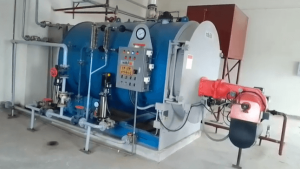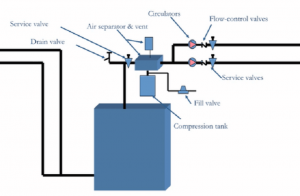Disclosure: As an Amazon Associate, I earn from qualifying purchases. Learn more
A heat pump has two parts: an evaporator and a condenser. The evaporator is filled with a liquid refrigerant. The refrigerant absorbs heat from the air, and this causes it to evaporate. The evaporated refrigerant then goes into the condenser, where it is compressed. This raises the temperature of the refrigerant. The hot refrigerant then goes back into the evaporator, and the cycle starts over.
A heat pump can move heat in either direction. To heat a home, the heat pump moves heat from the outside air into the home. To cool a home, the heat pump moves heat from the inside of the home to the outside.
Heat pumps are very efficient, and they can save a lot of money on heating and cooling costs.
How is a Heat Pump Related to an Air Conditioner?
Most people think of their air conditioner and heat pump as two separate systems. In fact, a heat pump is a type of air conditioner. Both systems use refrigerant to cool and heat your home. Here’s a look at how they work and how they’re different.
A heat pump is a device that transfers heat energy from a source of heat to a destination called a “heat sink”. Heat pumps are designed to move thermal energy in the opposite direction of spontaneous heat transfer, by absorbing heat from a cold space and releasing it into a warmer one. A heat pump uses a small amount of external power to accomplish the work of transferring energy from the heat source to the heat sink.
While a refrigerator moves heat from a lower temperature (it’s interior) to a higher one (the room), a heat pump can be used to move heat in either direction. When it is used to cool a space, it is called an air conditioner. When it is used to heat a space, it is sometimes called a reverse-cycle air conditioner, but more often simply a heat pump.
The main components of a heat pump system are the condenser, the evaporator, and the compressor. The condenser is located outside the home, and the evaporator is located inside. The compressor circulates refrigerant between the two coils.
As the refrigerant passes through the condenser, it releases its heat into the outside air. The refrigerant then passes through the expansion valve, where its pressure and temperature are reduced. The refrigerant then enters the evaporator, where it absorbs heat from the inside air. The refrigerant then passes back through the compressor, where it is pressurized and its temperature is increased. The process is then repeated.
The efficiency of a heat pump system is measured by its coefficient of performance (COP). The higher the COP, the more efficient the system. Heat pump systems are rated according to their heating and cooling capacities. Heating capacity is measured in British Thermal Units (BTUs) per hour, and cooling capacity is measured in tons. One ton is equal to 12,000 BTUs per hour.
When used for heating, a heat pump system can be supplemented with a backup heating system, such as a furnace. When used for cooling, a heat pump system can be supplemented with a backup cooling system, such as an evaporative cooler.

What are the Similarities between a Heat Pump And an Air Conditioner?
A heat pump and an air conditioner both work to transfer heat from one area to another. In the case of a heat pump, this is typically done in order to heat a home or office, while an air conditioner works to remove heat from an area in order to cool it down. Both systems use refrigerant in order to complete this process, and both have outdoor and indoor units.
The main similarity between the two lies in their basic function; however, there are also some key differences between heat pumps and air conditioners that should be noted. For starters, a typical air conditioner will only be able to move heat in one direction – from the indoors out. A heat pump, on the other hand, can actually reverse this process and remove heat from the outdoors and bring it inside.
This makes a heat pump an incredibly versatile option for those looking to regulate the temperature in their home or office year-round. Additionally, due to the way they operate, heat pumps tend to be much more energy efficient than air conditioners – making them a great choice for eco-conscious consumers.
Which is Better Heat Pump Or Air Conditioner?
The answer to this question depends on a number of factors, including the climate you live in, the size and layout of your home, and your personal preferences. In general, though, air conditioners are better suited for hot, humid climates, while heat pumps are a better choice for cold or moderate climates.Air conditioners work by removing heat from the air inside your home and pumping it outdoors.
This process makes the air inside your home cooler and more comfortable to be in. Heat pumps work by transferring heat from one place to another. In the winter, they take heat from the outdoor air and pump it indoors.
In the summer, they do the reverse – taking heat from indoors and pumping it outdoors.Both systems have their pros and cons. Air conditioners are typically more expensive to operate than heat pumps because they use more energy to remove heat from the air.
However, they are also more effective at cooling down a hot room quickly. Heat pumps can be less expensive to operate than air conditioners because they don’t use as much energy to transfer heat. But they aren’t as good at cooling a room quickly as an AC unit is.
Heat Pumps Explained – How Heat Pumps Work HVAC
FAQs
Q. How Does a Heat Pump Provide Both Heat And Air Conditioning?
A. A heat pump provides both heating and cooling for a home by moving heat from one place to another. In the winter, it takes heat from the inside of the home and moves it outside. In the summer, it does the reverse by taking heat from the outside air and moving it inside.
By doing this, a heat pump can provide year-round comfort for a home while using less energy than other types of heating and cooling systems.
Q. How Efficient is a Heat Pump?
A. When operating in the heating mode, a typical heat pump has a coefficient of performance (COP) of about 3. This means that for every unit of electricity used to power the heat pump, 3 units of heat are delivered into the home. In the cooling mode, the COP is about 4. So, for every unit of electricity used to power the heat pump, 4 units of heat are removed from the home.
Q. What are the Advantages of a Heat Pump?
A. The main advantages of a heat pump are that it is very efficient and can provide both heating and cooling.
Q. What are the Disadvantages of a Heat Pump?
A. The main disadvantages of a heat pump are that it requires more maintenance than a traditional furnace and air conditioner and it is not as effective in very cold weather.
Q. How Much Does a Heat Pump Cost?
A. The cost of a heat pump depends on the size of the unit, the type of unit, and the efficiency. A typical unit ranges in cost from $2,000 to $5,000.
Conclusion
In a nutshell, a heat pump is an air conditioner that can also work in reverse to provide heating. By switching the direction of the refrigerant flow, a heat pump can either remove heat from your home (cooling) or add heat to your home (heating).

